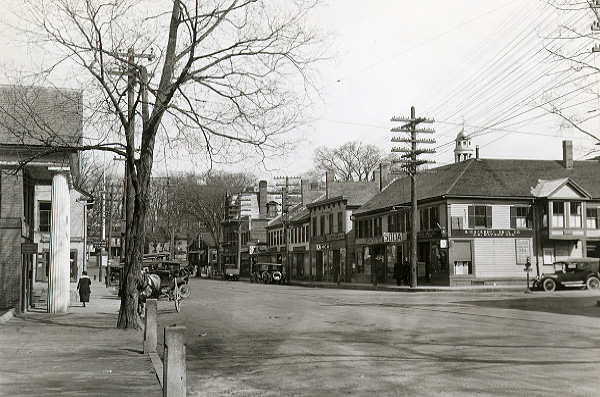

20. The Milldam from northwest (Concord Main Street) by Herbert Wendell Gleason, March 31, 1920
In 1928, an astonishing proposal was introduced to the people of Concord by Albert Y. Gowen, a millionaire cement manufacturer. Gowen had come to town just a year earlier, and had purchased a significant number of properties on the Mill Dam. Inspired by Colonial Williamsburg, then being recreated in Virginia and with which he was tangentially associated, Gowen planned to demolish the existing buildings on each side of Main Street and reconstruct the Mill Dam in what he believed to be traditional colonial architectural style. Though historic preservation and recreation were popular at the time, this wasn’t to be a tourist attraction, but instead Concord’s commercial center.
Gowen’s proposed project benefited from the thinly-veiled boosterism of Wentworth Stewart, founder, publisher and editor of the Concord Journal. Throughout the summer and into the fall of 1928 the newspaper was filled with articles and letters about the controversy. Ostensibly, Gowen’s plan was meant to ensure that the Mill Dam would maintain a consistent architectural appearance for decades to come, preventing the historic town's center from becoming a cacophony of building styles, and assuring that old, decaying buildings would not blight the historic landscape. It was also intended to be a profit-making undertaking, not just for Gowen and wealthy speculators, but for anyone interested in investing from $50 to $5000 in the venture.
One of those most vehemently opposed to the project was Frank Pierce, second generation owner of the Mill Dam property next to Anderson’s Market. He was outspoken in his disapproval of the project and adamant in his refusal to sell to Gowen. Oddly, though Concord center’s original developer, the Concord Mill Dam Company, had been incorporated in 1828—exactly one hundred years earlier—neither supporting nor opposing factions mentioned it. Had he been aware of the Company's existence, Gowen could have made good use of it as an example to argue for a similar project to upgrade the center of Concord.
After a year and a half of wrangling, Gowen gave up the fight for a Williamsburg-style Mill Dam. In 1929, he discontinued the project, selling the properties he had acquired (some of them back to the original owners). He withdrew from the limelight, remaining in Concord until around 1937. Concord’s Mill Dam, including the Anderson Market building, had been spared the fate of becoming a developer’s fairytale notion of the way a New England town center should look.